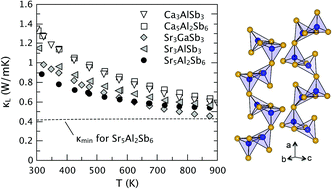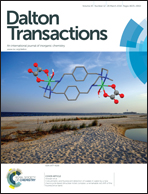Thermoelectric properties and electronic structure of the Zintl phase Sr5Al2Sb6
Abstract
The Zintl phase Sr5Al2Sb6 has a large, complex unit cell and is composed of relatively earth-abundant and non-toxic elements, making it an attractive candidate for thermoelectric applications. The structure of Sr5Al2Sb6 is characterized by infinite oscillating chains of AlSb4 tetrahedra. It is distinct from the structure type of the previously studied Ca5M2Sb6 compounds (M = Al, Ga or In), all of which have been shown to have promising thermoelectric performance. The lattice thermal conductivity of Sr5Al2Sb6 (∼0.55 W mK−1 at 1000 K) was found to be lower than that of the related Ca5M2Sb6 compounds due to its larger unit cell (54 atoms per primitive cell). Density functional theory predicts a relatively large band gap in Sr5Al2Sb6, in agreement with the experimentally determined band gap of Eg ∼ 0.5 eV. High temperature electronic transport measurements reveal high resistivity and high Seebeck coefficients in Sr5Al2Sb6, consistent with the large band gap and valence-precise structure. Doping with Zn2+ on the Al3+ site was attempted, but did not lead to the expected increase in carrier concentration. The low lattice thermal conductivity and large band gap in Sr5Al2Sb6 suggest that, if the carrier concentration can be increased, thermoelectric performance comparable to that of Ca5Al2Sb6 could be achieved in this system.


 Please wait while we load your content...
Please wait while we load your content...